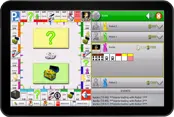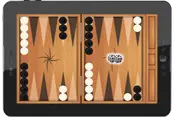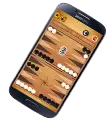ONLINE Nine Mens Morris
SCREENSHOTS
DESCRIPTION
Nine Men's Morris (a.k.a The Mill) is free online board game. It is standard game for two people, in which you have to destroy opponent chips by making Mills of 3 chips in horizontal or vertical direction
Play free Nine Mens Morris or play other board games online.
Play free Nine Mens Morris or play other board games online.
RANKINGS
- TOP PLAYERS
- ACTIVE PLAYERS TODAY
- TOP DAY PLAYERS
- TOP WEEK PLAYERS
- TOP MONTH PLAYERS
RULES OF Nine Mens Morris
Rules of play
Each player has nine pieces, or "men", which move among the board's twenty-four spots. The object of the game is to leave the opposing player with fewer than three pieces or, as in checkers, no legal moves.
Placing the pieces
The game begins with an empty board. Players take turns placing their pieces on empty spots. If a player is able to form a straight row of three pieces along one of the board's lines (i.e. not diagonally), he has a "mill" and may remove one of his opponent's pieces from the board; removed pieces may not be placed again. Players must remove any other pieces first before removing a piece from a formed mill. Once all eighteen pieces have been used, players take turns moving.
Moving the pieces
To move, a player slides one of his pieces along a board line to an empty adjacent spot. If he cannot do so, he has lost the game. As in the placement stage, a player who aligns three of his pieces on a board line has a mill and may remove one of his opponent's pieces, avoiding the removal of pieces in mills if at all possible. Any player reduced to two pieces is unable to remove any more opposing pieces and thus loses the game.
Flying
In one common variation, once a player is reduced to three pieces, his pieces may "fly", "hop" or "jump" to any empty spots, not only adjacent ones. Some sources of the rules say this is the way the game is played, some treat it as a variation, and some don't mention it at all. A '19th Century Games Manual' calls this the "truly rustic mode of playing the game".
Strategy
At the beginning of the game, it is more important to place pieces in versatile locations rather than to try to form mills immediately and make the mistake of concentrating one's pieces in one area of the board. An ideal position, which typically results in a win, is to be able to shuttle one piece back and forth between two mills, removing a piece every turn. For example, in the diagram above, White can win the game even if Black moves first.
Each player has nine pieces, or "men", which move among the board's twenty-four spots. The object of the game is to leave the opposing player with fewer than three pieces or, as in checkers, no legal moves.
Placing the pieces
The game begins with an empty board. Players take turns placing their pieces on empty spots. If a player is able to form a straight row of three pieces along one of the board's lines (i.e. not diagonally), he has a "mill" and may remove one of his opponent's pieces from the board; removed pieces may not be placed again. Players must remove any other pieces first before removing a piece from a formed mill. Once all eighteen pieces have been used, players take turns moving.
Moving the pieces
To move, a player slides one of his pieces along a board line to an empty adjacent spot. If he cannot do so, he has lost the game. As in the placement stage, a player who aligns three of his pieces on a board line has a mill and may remove one of his opponent's pieces, avoiding the removal of pieces in mills if at all possible. Any player reduced to two pieces is unable to remove any more opposing pieces and thus loses the game.
Flying
In one common variation, once a player is reduced to three pieces, his pieces may "fly", "hop" or "jump" to any empty spots, not only adjacent ones. Some sources of the rules say this is the way the game is played, some treat it as a variation, and some don't mention it at all. A '19th Century Games Manual' calls this the "truly rustic mode of playing the game".
Strategy
At the beginning of the game, it is more important to place pieces in versatile locations rather than to try to form mills immediately and make the mistake of concentrating one's pieces in one area of the board. An ideal position, which typically results in a win, is to be able to shuttle one piece back and forth between two mills, removing a piece every turn. For example, in the diagram above, White can win the game even if Black moves first.
















